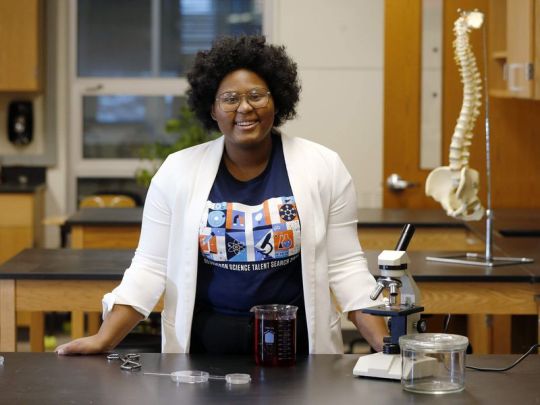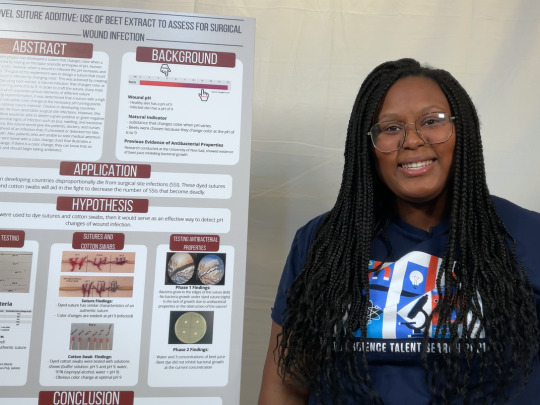#dasia taylor
Text
Dasia Taylor: Black Scientist Who Invented Dye For Sutures To Detect Infection
At age 15, Black scientist Dasia Taylor invented a suture that changes color to reflect if a wound is healing properly. Click the link to learn more or listen via podcast.
#Blackmail4u #BlackHistory #Blackinventor #DasiaTaylor #BlackScientist #STEM
Welcome To Black Mail!
Where we bring you Black History, Special Delivery.
Scientist and inventor Dasia Taylor was born on April 6, 2004, in Chicago, Illinois. Taylor graduated from Iowa City West High School in Iowa City, Iowa, in 2021.
In 2019, at age fifteen, Taylor conducted an experiment with beets. She discovered that dye from beets applied to surgical sutures would change color at a…

View On WordPress
#African American History#Black History#Black History Fact#Black History Month#black inventor#BLACK SCIENTIST#blackmail4u#Dasia Taylor#STEM
7 notes
·
View notes
Text
#dasia taylor#womyn making herstory#black women making herstory#black womyn making herstory#black women making history#women making history#herstoric#herstorical#historic#historical#medical discoveries by women#women in medicine#womyn in medicine#i love womyn#i love women
3 notes
·
View notes
Text
This High Schooler Invented Color-Changing Sutures to Detect Infection | Innovation| Smithsonian Magazine

3 notes
·
View notes
Text

This is Dasia Taylor.
She invented a new type of suture that changes color to show if a wound is infected.
She won the state science fair, became a finalist in a national competition, and now has her sights set on a patent.
She's only 17.
#repost#women#science#black women#black women history#women in science#teenagers#teens#medical#medicine
3 notes
·
View notes
Text

Dasia Taylor was (born April 6, 2004) a teenage scientist and inventor who was born in Chicago to LaDonna Phillips. When she was eight, they moved to Madison, Indiana, and on to Iowa City, Iowa. She graduated from Iowa City West High School.
She is known for her experiment where she juiced at least three dozen beets in the last 18 months based on a project she began in October 2019 when she was 15 years old. she discovered that beets changed color at the perfect pH point. Her discovery showed that these root vegetables could provide surgical suture thread that could change color from bright red dark to dark purple to reflect the healing of an infected wound. She was able to find a suture thread that would hold onto the beet dye by testing ten different materials.
She has been an anti-racist curriculum advocate since 2017. To challenge those who doubted her abilities, in 2020 the 16-year-old devoted four months to concentrating and committing herself to research preparing for her first regional science and math fair.
She was recognized as one of 40 finalists in the Regeneron Science Talent Search. This STEM-based activity is one of the oldest and most prestigious science and math competitions for high school seniors in the US. She received $25,000 for her discovery from the Iowa City Press-Citizen.
She has also been pursuing a line of research that might counteract the risks posed by using cotton. She spent a considerable amount of time and energy in the Black History Game Show as its president and she often attends weekly school board and district meetings.
She received the Glenn T. Seaborg Award, recognizing and encouraging research and education in nuclear chemistry and radiochemistry. She has appeared on The Ellen DeGeneres Show. She is preparing to take ownership of her inventions by patenting them. #africanhistory365 #africanexcellence
0 notes
Text
Have to share this!!!!
#poc#women of color#science#medical science#brilliant women#amazing#black woman#more women in stem#amazing work
1 note
·
View note
Text
Some good news from earlier this year that I missed: a student named Dasia Taylor, age 17, created medical sutures that change color to show if a wound is infected. This invention could save the lives of people around the world, especially women who receive Cesarean sections.

578 notes
·
View notes
Photo

Good news of the day: 17-yo Dasia Taylor invented a suture thread that changes color, from bright red to dark purple, when a surgical wound becomes infected. This would be a game-changing technology, as in developing countries about 10% of surgical wounds become infected (the rate is about 3% in the US).
(That rate goes up to 20%, respectively 10%, in surgeries related to childbirth.)
[read more]
149 notes
·
View notes
Link
After winning a state science fair and becoming a finalist in a national competition, Dasia Taylor now has her sights set on a patent
1 note
·
View note
Photo

This High Schooler Invented Color-Changing Sutures to Detect Infection
By Theresa Machemer
Dasia Taylor has juiced about three dozen beets in the last 18 months. The root vegetables, she’s found, provide the perfect dye for her invention: suture thread that changes color, from bright red to dark purple, when a surgical wound becomes infected.
The 17-year-old student at Iowa City West High School in Iowa City, Iowa, began working on the project in October 2019, after her chemistry teacher shared information about state-wide science fairs with the class. As she developed her sutures, she nabbed awards at several regional science fairs, before advancing to the national stage. This January, Taylor was named one of 40 finalists in the Regeneron Science Talent Search, the country’s oldest and most prestigious science and math competition for high school seniors.
....
“I've done a lot of racial equity work in my community, I've been a guest speaker at several conferences,” says Taylor. “So when I was presented with this opportunity to do research, I couldn't help but go at it with an equity lens.”
Before the Covid-19 pandemic, Taylor spent most of her time after school in the Black History Game Show, a club she’s been a member of since eighth grade, and attending weekly school board and district meetings to advocate for an anti-racist curriculum. For the four months leading up to her first regional science fair in February 2020, Taylor committed Friday afternoons to research under the guidance of her chemistry teacher, Carolyn Walling.
Healthy human skin is naturally acidic, with a pH around five. But when a wound becomes infected, its pH goes up to about nine. Changes in pH can be detected without electronics; many fruits and vegetables are natural indicators that change color at different pH levels.
“I found that beets changed color at the perfect pH point,” says Taylor. Bright red beet juice turns dark purple at a pH of nine. “That's perfect for an infected wound. And so, I was like, ‘Oh, okay. So beets is where it's at.’”
Next, Taylor had to find a suture thread that would hold onto the dye. She tested ten different materials, including standard suture thread, for how well they picked up and held the dye, whether the dye changed color when its pH changed, and how their thickness compared to standard suture thread. After her school transitioned to remote learning, she could spend four or five hours in the lab on an asynchronous lesson day, running experiments.
A cotton-polyester blend checked all the boxes. After five minutes under an infection-like pH, the cotton-polyester thread changes from bright red to dark purple. After three days, the purple fades to light gray.
Working with an eye on equity in global health, she hopes that the color-changing sutures will someday help patients detect surgical site infections as early as possible so that they can seek medical care when it has the most impact. Taylor plans to patent her invention. In the meantime, she’s waiting for her final college admissions results.

13K notes
·
View notes
Text
This High Schooler Invented Color-Changing Sutures to Detect Infection | Innovation| Smithsonian Magazine

0 notes
Photo

This High Schooler Invented Color-Changing Sutures To Detect Infection - After Winning A State Science Fair And Becoming A Finalist In A National Competition, Dasia Taylor Now Has Her Sights Set On A Patent https://ift.tt/39gyeJZ
287 notes
·
View notes
Text
37 notes
·
View notes